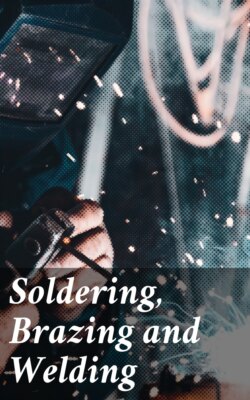Читать книгу Soldering, Brazing and Welding - Группа авторов - Страница 8
На сайте Литреса книга снята с продажи.
Making Solder Strips, Wire, Tears, etc.
ОглавлениеTable of Contents
—Only clean, pure tin and pure lead should be employed. The lead is first melted and then the tin added. When all is melted, place a piece of resin on the molten metal to act as a flux, and after well stirring, the solder is made into strips by pouring from a ladle. Solder should not be poured into sand. It may be poured into strips on an oiled sheet of black iron, preferably corrugated to accommodate the strips. In the absence of a corrugated iron sheet, some workers use a ladle resembling a large spoon with a hole about 1⁄16 in. in diameter near the end. To form the strips, get a ladle full of solder, place it on a flat iron sheet; then, tilting the ladle to allow the solder to flow over the hole, quickly draw the ladle across the sheet. A thin strip of solder should thus be formed, and the thickness of the strip may be varied by increasing or decreasing the diameter of the hole in the ladle. A button of solder usually forms at one or both ends of the strip, and this excess should be melted off the strips by just dipping the ends into the molten solder in the pot.
Soft Solders for Various Metals
| Metal to be soldered | Flux | Soft Solder | |||||||||
|---|---|---|---|---|---|---|---|---|---|---|---|
| Tin | Lead | Other constituents | |||||||||
| Aluminium | stearin | see table on p. 59 | |||||||||
| Brass | - | [1] | zinc chloride, resin or ammonium chloride | - | 66 | 34 | |||||
| Gunmetal | 63 | 37 | |||||||||
| Copper | 60 | 40 | |||||||||
| Lead | tallow or resin | 33 | 67 | ||||||||
| Block tin | zinc chloride | 99 | 1 | ||||||||
| Tinplate | zinc chloride or resin | 64 | 36 | ||||||||
| Galvanised steel | hydrochloric acid | 58 | 42 | ||||||||
| Zinc | hydrochloric acid | 55 | 45 | ||||||||
| Pewter | gallipoli oil | 25 | 25 | bismuth, 50 | |||||||
| Iron and steel | ammonium chloride | 50 | 50 | ||||||||
| Britannia metal | tallow or resin | 25 | 25 | bismuth, 50 | |||||||
| Gold | zinc chloride | 67 | 33 | ||||||||
| Silver | zinc chloride | 67 | 33 | ||||||||
| Bismuth | zinc chloride | 33 | 33 | bismuth, 34 | |||||||
| [1] Zinc chloride is the ordinary “killed spirits.” |
Solder wire is very handy for small work, and can be made in the following way: Roll a sheet of stiff writing or drawing paper into a conical form, rather broad in comparison with its length; make a ring of stiff wire to hold it in, attaching a suitable handle to the ring. The point of the cone should first of all be cut off to leave an orifice of the size required. It should then be filled with molten solder, and held above a pail of cold water, and the stream of solder flowing from the cone will solidify as it runs and form the wire. If held a little higher, so that the stream of solder breaks into drops before striking the water, it will form handy elongated “tears” of metal; when it is held still higher, each drop forms a thin concave cup or shell, and each of these forms will be found to have its own peculiar uses in blowpipe work.
The method adopted for granulating tinman’s solder, which is very rarely called for, is as follows: Place a piece of wood, well greased, over a tub containing water, and by gently pouring the molten alloy from a distance in a small stream on to the greased board, the metal is broken up into a large number of very fine shots, which run off the board into the water and are immediately cooled. The fine shots are then taken from the water and gently dried.
